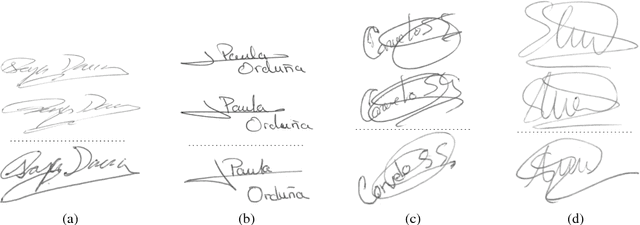Learning Features for Offline Handwritten Signature Verification using Deep Convolutional Neural Networks
Paper and Code
May 16, 2017



Verifying the identity of a person using handwritten signatures is challenging in the presence of skilled forgeries, where a forger has access to a person's signature and deliberately attempt to imitate it. In offline (static) signature verification, the dynamic information of the signature writing process is lost, and it is difficult to design good feature extractors that can distinguish genuine signatures and skilled forgeries. This reflects in a relatively poor performance, with verification errors around 7% in the best systems in the literature. To address both the difficulty of obtaining good features, as well as improve system performance, we propose learning the representations from signature images, in a Writer-Independent format, using Convolutional Neural Networks. In particular, we propose a novel formulation of the problem that includes knowledge of skilled forgeries from a subset of users in the feature learning process, that aims to capture visual cues that distinguish genuine signatures and forgeries regardless of the user. Extensive experiments were conducted on four datasets: GPDS, MCYT, CEDAR and Brazilian PUC-PR datasets. On GPDS-160, we obtained a large improvement in state-of-the-art performance, achieving 1.72% Equal Error Rate, compared to 6.97% in the literature. We also verified that the features generalize beyond the GPDS dataset, surpassing the state-of-the-art performance in the other datasets, without requiring the representation to be fine-tuned to each particular dataset.
 Add to Chrome
Add to Chrome Add to Firefox
Add to Firefox Add to Edge
Add to Edge